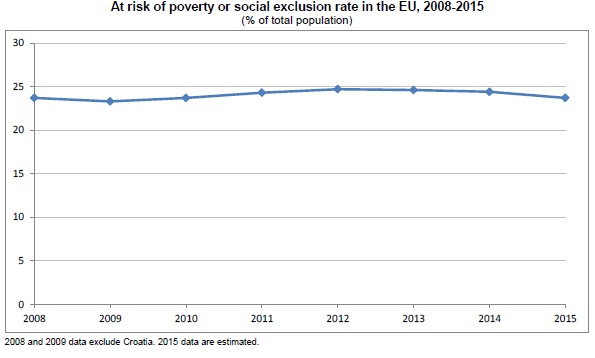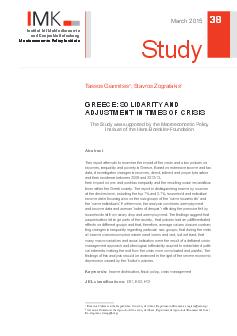OECD, (2019), “Low productivity jobs continue to drive employment growth”, 29 Απριλίου Employment is rising in OECD countries but most jobs continue to be created in relatively low-productivity, low-wage activities, says a new OECD report. The latest Compendium of Productivity Indicators says the trend has compounded the impact of generally weak business investment on productivity growth. The downward pressure on wages may have allowed firms to defer investment decisions, instead …Read More
Search Results for: eu poverty indicator
Why is it so hard to reach the EU’s ‘poverty’ target?
Darvas, Zsolt, (2017), “Why is it so hard to reach the EU’s ‘poverty’ target?”, Bruegel, 19 Ιανουαρίου The ‘poverty’ target set by the European Commission aims to lift “over 20 million people out of poverty” between 2008 and 2020 in the EU27. Progress to date against this target has been disappointing. Why is it so hard to reach the Europe 2020 ‘poverty’ target? What does the poverty indicator actually measure? …Read More
The share of persons at risk of poverty or social exclusion in the EU back to its pre-crisis level
Eurostat/The share of persons at risk of poverty or social exclusion in the EU back to its pre-crisis level/199/2016 – 17 October 2016 In 2015, around 119 million people, or 23.7% of the population, in the European Union (EU) were at risk of poverty or social exclusion. This means that they were in at least one of the following three conditions: at-risk-of-poverty after social transfers (income poverty), severely materially deprived …Read More
The EU Convergence Machine at Work. To the Benefit of the EU’s Poorest Citizens?
Goedemé, Tim, Collado, Diego, (2016), “The EU Convergence Machine at Work. To the Benefit of the EU’s Poorest Citizens?”, Journal of Common Market Studies, 6 Απριλίου Social cohesion in the EU (European Union) is usually assessed on the basis of GDP per capita and relative poverty rates. These indicators show that the ‘European convergence machine’ led to greater social cohesion between old and new Member States (EU-15 and NMS) until the onset of …Read More
Improving the measurement of material deprivation at the European Union level
Guio, Anne-Catherine, Marlier, Eric, Gordon, David, Fahmy, Eldin, Nandy, Shailen, Pomati, Marco, (2016), “Improving the measurement of material deprivation at the European Union level”, Journal of European Social Policy, Ιούνιος In June 2010, European Union (EU) Heads of State and Government adopted a social inclusion target as part of the new ‘Europe 2020 Strategy’: to lift at least 20 million people in the EU from the risk of poverty and exclusion by 2020. One of the three indicators used to monitor …Read More
Europe 2020 indicators – poverty and social exclusion
Eurostat/Europe 2020 indicators – poverty and social exclusion/March 2016 This article is part of a set of statistical articles on the Europe 2020 strategy. It provides recent statistics on poverty and social inclusion in the European Union (EU). The Europe 2020 strategy is the EU’s agenda for growth and jobs for the current decade. It emphasises smart, sustainable and inclusive growth as a way to overcome the structural weakness in Europe’s economy, to improve its competitiveness …Read More
Improvement during Crisis Years? Poverty and Housing Conditions across the EU, 2007 – 2012
Lelkes, Orsolya, Zólyomi, Eszter, (2015), “Improvement during Crisis Years? Poverty and Housing Conditions across the EU, 2007 – 2012”, Policy Brief September 2015 The Policy Brief aims to provide an overview of housing deficiencies in EU Member States and to examine the extent to which they are linked to low income. Housing is a key aspect of poverty and social exclusion.The quality of housing has an impact on, for instance, social relations …Read More
How long before growth and employment are restored in Greece?
Papadimitriou, Dimitri B., Nikiforos, Michalis, Zezza, Gennaro, (2016), “How long before growth and employment are restored in Greece?”, Levy Economics Institute of Bard College, Strategic Analysis, Ιανουάριος. The Greek economy has not succeeded in restoring growth, nor it has managed to restore a climate of reduced uncertainty, which is crucial for stabilizing the business climate that promotes investment. On the contrary, a new round of austerity measures that has agreed upon will imply another year of …Read More
Greece: Solidarity and Adjustment in Times of Crisis
Giannitsis, Τ. & Zografakis, S. (2015) “Greece: Solidarity and Adjustment in Times of Crisis“, Hans-Böckler-Stiftung, IMK Studies, Nr. 38., Düsseldorf: Μάρτιος. This report attempts to examine the impact of the crisis and crisis policies on incomes, inequality and poverty in Greece. Based on extensive income and tax data, it investigates changes in incomes, direct, indirect and property taxation and their incidence between 2008 and 2012-13, their impact on pre- …Read More
Migrant integration statistics – social inclusion
Eurostat Statistics Explained: Migrant integration statistics – social inclusion, 21 Νοεμβρίου. Migrants play an important role in the labour markets and economies of the countries they settle in. This article presents European Union statistics on the social inclusion of migrants as part of monitoring their integration and assessing their situation in the labour market. This in turn makes it easier to evaluate the outcomes of integration policies. The indicators …Read More







